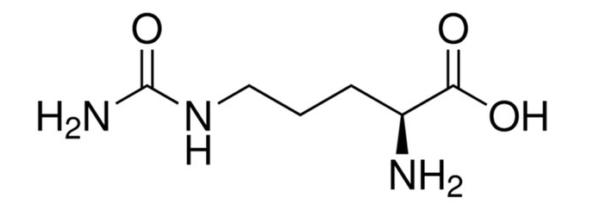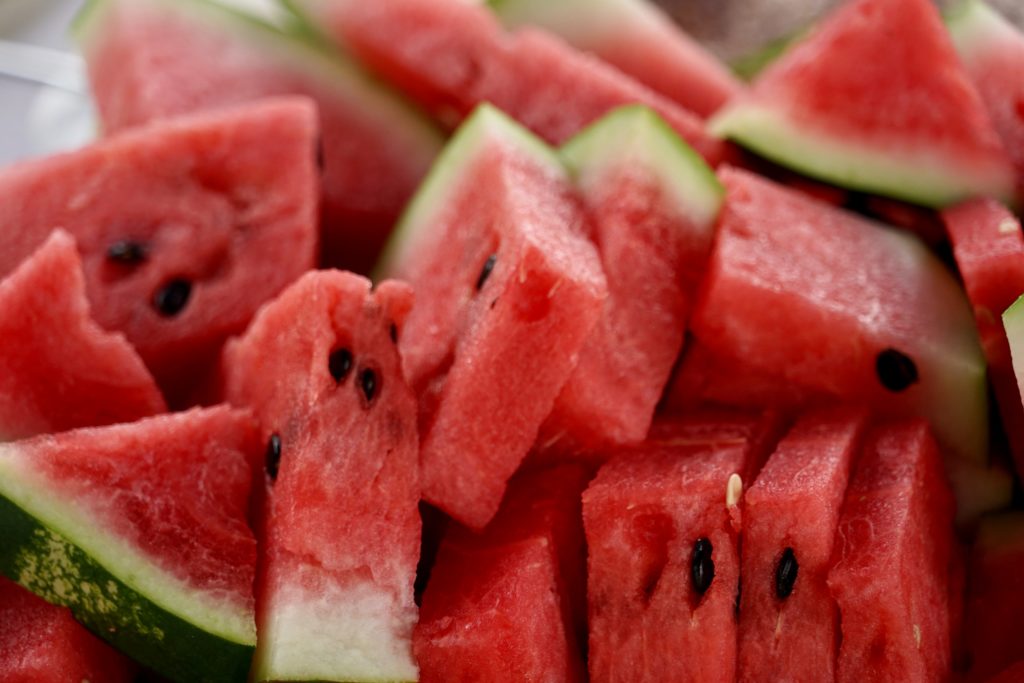Let me ask you this:
What’s the first ingredient that pops to mind when you hear the term ‘pre-workout supplements?’
Well, yes, okay – caffeine, creatine, beta-alanine, and arginine are probably the compounds that come to mind.
Okay, okay. Let me paraphrase the question:
What’s the fifth(ish) ingredient that pops to mind?
If you thought of citrulline malate, then you’re in luck today because we’ll be taking a very close look at this ingredient.
L-Citrulline has many benefits for bodybuilders. It is “pump” inducing, may improve recovery time, may increase strength and power and will likely lead to an increase in muscle growth. It may even improve your heart health. Dosage timing isn’t incredibly important, but dosage amount is.
By the end of this article, you’ll know everything about citrulline malate, what research has to say about it, and why it’s become so popular and common in pre-workouts.

But First: What is L-Citrulline?
L-citrulline is a non-essential amino acid, which means that we don’t necessarily need to get it through food or supplementation, as the body can produce it. But the tricky bit with non-essential amino acids is that, while the body might be able to produce them, it may not be able to make enough to cover all needs.
For example, glycine is a non-essential amino acid that plays a crucial role in many processes. At first glance, supplementing with it seems unnecessary – after all, the body produces it on its own. But, as it turns out, if you’d like to reap its full benefits, you need to be mindful and get enough through food and supplementation.
The same goes for l-citrulline. While the body does produce some quantity of the amino acid, it doesn’t create enough to bring about the associated benefits that come from supplementation.
So, because of that, supplementing with it seems like the best course of action. The most common form of the amino acid is citrulline malate – the combination of the amino acid (citrulline) with malic acid.

L-Citrulline and Muscle Recovery
This is a bit of a controversial idea because we’ve seen some conflicting reports from studies on the topic.
For example, in one study from 2017, researchers set out to examine the effects of citrulline malate supplementation on muscle recovery after training (1). The protocol had nine young and untrained men either take 6 grams of citrulline or a placebo closely before each workout. After seven days, their conditions were switched. All subjects received fatigue tests at 24, 48 and 72 hours post-training to assess their recovery status.
Researchers couldn’t find differences in recovery markers between the placebo and citrulline group at any point. More specifically, they examined testosterone to cortisol ratio, maximum repetitions, rate of perceived exertion, creatine kinase, and lactate levels.
With that said, it’s worth noting that the study was very short-term (only two occasions of citrulline supplementation for each subject), and it had very few participants. How these effects might present themselves among more subjects and a longer period remains to be seen.
In one study from 2010, researchers wanted to determine citrulline’s effects on relatively high-intensity exercise (bench press) performance and the rate of perceived muscle soreness following that (2). Forty-one subjects performed 16 sets on two separate occasions – once taking a placebo beforehand and once having 8 grams of citrulline malate.
Researchers found that citrulline malate supplementation led subjects to perform nearly 53 percent more repetitions when compared to placebo. For example, if subjects in the placebo group did 100 repetitions for the workout, citrulline malate supplementation bumped that number to 153. What’s more, there was a 40 percent reduction in muscle soreness in the pecs at 24 and 48 hours post-training.
So, while we certainly do need more studies before concluding, citrulline malate appears to be quite beneficial, especially when exercise performance is involved.
L-Citrulline and the ‘Pump’
This is perhaps the most popular benefit of citrulline. In fact, the amino acid is primarily used in pre-workout supplements to help bring about vasodilation and a better pump.
Vasodilation is important for physical performance and overall health, as the process entails the widening of our arteries and veins, which allows for more blood to flow throughout the body (3, 4). Vasodilation also helps lower blood pressure as it reduces cardiac resistance, which can be quite beneficial for some folks (3, 4).
The mechanism by which the amino acid achieves this is quite simple. Once consumed, some part of citrulline is converted to another amino acid – arginine – which itself is converted into a molecule called nitric oxide (NO). Nitric oxide helps bring about vasodilation by relaxing smooth muscle cells that cause vasoconstriction (5, 6).
Now, you might be asking yourself, “Well, why not just supplement with arginine in that case?” We’ll cover that in one of the later points.
Suggestion: If you are after a pump, click this link to check out another article on Pump Some Iron about Agmatine.

L-Citrulline as a Performance-Enhancer (Ergogenic Benefits)
Vasodilation is not only beneficial for getting a sick pump in the gym – it can also bring about other benefits like strength, power, and endurance.
This is because improved blood flow allows for more nutrients and oxygen to travel to your muscles. A greater delivery of nutrients and oxygen means that your muscles reach a fatigued state more slowly, and you can exert more force throughout your workout.
Another benefit of the increased blood flow is that waste and metabolic by-products get transported out of your muscles more quickly. A build-up of metabolites, for example, brings about the familiar burning sensation and the closely-following fatigue (7). By getting some of it out of your muscles, you can delay that inevitable fatigue.
These mechanisms and potential benefits are also supported by quite a bit of research. For example, one interesting study from 2016 had 17 female subjects take 8 grams of citrulline malate or a placebo (8). An hour later, subjects completed several physical performance tests.
Researchers found that grip strength, peak power, and explosive power were significantly higher when subjects consumed citrulline malate.
Another study found similar ergogenic effects from citrulline supplementation (9). In it, researchers sought to determine the effects of citrulline supplementation on cycling performance. They found that subjects who took 2.4 grams of citrulline per day for a week had higher arginine levels and performed better on the cycling trial (completing the trial 1.5 percent faster).
Similar findings were presented in other studies (10, 11, 12, 13, 14). All in all, the amino acid shows quite a bit of promise concerning athletic performance.
L-Citrulline and Muscle Growth
There are a couple of ways in which citrulline supplementation might help with muscle growth.
First, some research suggests that citrulline can increase protein synthesis through its effects on an important signaling pathway (15, 16). To be sure, we need more research in this area, but the studies so far have begun painting a promising picture.
Another mechanism worth looking at here is citrulline’s effect on the liver. More specifically, one study found that citrulline may prevent the liver from absorbing certain amino acids, which helps prevent their breakdown (17).
The other possible way in which citrulline supplementation might aid in muscle growth is thanks to its performance-enhancing benefits. We’ve known for a while that training volume is a critical factor for muscle growth – more work delivers better results, to a point, of course (18).
And by supplementing with citrulline malate, we could do a bit more work in each training session, which, over time, would compound to more significant strength and muscle gains.
To the best of my knowledge, one study so far has examined these potential effects (19). The protocol lasted for eight weeks, and the 75 resistance-trained subjects were given glutathione with l-citrulline malate, citrulline malate alone, or a placebo every day. Subjects also did body composition and muscle strength tests before the study began, at week 4, and at week 8.
Researchers found that, when compared to placebo, subjects who were given glutathione with l-citrulline malate had greater increases in muscle. Subjects in that group also saw greater strength gains, which could partially or fully be explained by the greater muscle growth.

L-Citrulline and Heart Health
We previously covered the effects citrulline malate (and, by extension, arginine, and nitric oxide) has on vasodilation and blood pressure. The ability for blood vessels to widen and increase blood flow is not only beneficial for having better workouts, but it also helps normalize blood pressure and reduce the strain on your heart.
Stiff and narrow blood vessels not only decrease the body’s ability to deliver oxygenated blood everywhere but is also a significant risk factor for heart attack and stroke.
What’s interesting is that a single dose of citrulline malate doesn’t appear to help widen blood vessels both in healthy and sick individuals (20). This appears logical because it takes multiple doses of citrulline before arginine levels rise to a significant degree.
Research has found that multiple doses of citrulline malate can make a difference. For example, in one study, participants were given a placebo or 5.6 grams of citrulline malate for seven days (21). Although there weren’t significant differences in blood pressure, arterial stiffness was improved in the citrulline malate group.
Research on people with heart disease also shows a lot of promise, as it appears that citrulline supplementation marginally improves arterial health and decreases lipoprotein oxidation (22, 23).
So, while we certainly need further trials to solidify these findings, it seems like citrulline malate may prove to be quite beneficial for overall cardiovascular health.
Here’s Jim Stoppani on Citrulline VS Arginine:
L-Citrulline Malate vs. Arginine: Who’s the Winner Here?
We briefly touched upon citrulline metabolism earlier in this guide and concluded that some amount of the amino acid gets converted to arginine, which itself plays an important role in nitric oxide (NO) production.
So, why then bother supplementing with citrulline rather than simply taking arginine? It feels like an unnecessary extra step, right?
Well, as it turns out, supplementing with citrulline malate may increase arginine levels more than supplementing with arginine itself (24, 25). This effect can largely be explained by the differences in how the body processes arginine and citrulline malate (16).
Citrulline tends to be transported and absorbed much more efficiently, while direct arginine supplementation leads to significant losses along the way. So it appears that supplementing with citrulline is much more beneficial, especially when compared to arginine.
Below (and in the featured image on this post) is Calum Von Moger. He’s an Australian bodybuilder and actor. He sells a pre-workout called Koala Freak 2.0 that contains the recommended 6g Citrulline Malate with a 2:1 ratio. You can click this link to check it out on Amazon.
View this post on Instagram
Citrulline Malate vs. L-Citrulline: Is There a Difference?
There’s been a bit of a debate going around as to which citrulline supplement form is best for performance and overall health effects. On the one hand, some folks argue in favor of l-citrulline as it supposedly offers a pure form of the amino acid, and, thus, is superior.
On the other hand, citrulline malate also has its club of supporters who claim that it is the better and more cost-effective option.
So, who is right here?
Well, we can’t say for certain, especially because the two supplement forms haven’t been compared in a controlled study (to the best of my knowledge).
What we do know is that citrulline is beneficial on multiple fronts, so taking any supplement that has an adequate dose of the amino acid is going to be good for you.
But what about malic acid? Well, this is a naturally-occurring compound, most commonly found in fruits (like apples) that supposedly helps with the creation of cellular energy (ATP), though research is quite sparse here (26).
I do still recommend supplementing with citrulline malate because malic acid shows some promise with regards to energy production. Plus, most of the research (including the studies we’ve reviewed so far) that demonstrated the ergogenic benefits used citrulline malate, so there could be something to it.
And seeing as there doesn’t appear to be a drawback to citrulline malate, I’d go with it, at least as far as athletic performance is concerned.

L-Citrulline: Dosage and Timing
The majority of research so far has used a model where participants take citrulline malate close to their workouts, similarly to how one would take a stimulant to gain an acute benefit.
But, we also need to remember that a single dose of citrulline might not be enough to raise arginine levels (at least not to a significant enough degree). In that case, what matters more than timing (e.g., taking a dose before a workout) is the actual dose amount.
So far, research seems to suggest that 6 to 8 grams of citrulline malate is the sweet spot for athletic benefit. Up to 5 grams of citrulline malate could be enough to deliver other benefits like reduced blood pressure and reduced arterial stiffness.
As for timing, while citrulline is often touted as a pre-workout supplement, it seems that, so long as you take your daily dose, you should be able to reap the full benefit regardless of when you take it. Still, if you’d prefer to supplement with it before training, that’s completely fine.
A word of warning, though:
Citrulline malate has quite the sour taste (thanks to the malic acid), so it’s a good idea to try and mask it with a flavored drink of some sort. I’ve found orange juice to work quite well.
What Should You Expect From Supplementing With Citrulline?
If you haven’t taken citrulline before and you’ve read everything so far, you’re probably excited about it and want to see what it’s all about. And that’s not necessarily a bad thing.
But, it’s important to remember that citrulline malate is a supplement. As such, you can’t expect it to have steroid-like effects on you. What matters much more is that you pay attention to your nutrition, recovery, and training. Once you’ve locked in all three, you can then take advantage of supplements as the cherry on top.
With that said, supplementing with citrulline will likely yield the following benefits:
- Improved pumps and better circulation;
- More energy;
- A couple of extra reps on some exercises;
- Less prominent burns on high-repetition sets (delayed fatigue);
Some folks experience these immediately (could also be the placebo effect, at least to some extent); others need to take a few doses before getting any benefit.

Does L-Citrulline Supplementation Have Any Side-Effects and Drawbacks?
Fortunately, it doesn’t appear to. Citrulline has been studied for quite some years, and no research shows adverse effects, even at higher doses.
The only potential drawback seems to be minor GI discomfort in a small percentage of participants (27). But this effect seems to go away after taking a few doses, if the participants experiment by taking it on an empty stomach, or if the large dose is broken down into multiple, smaller ones.
It’s worth pointing out that we still need more research before confirming citrulline’s long-term safety when supplemented in larger doses.

How Should You Go About Taking Citrulline?
L-citrulline can most commonly be found in pre-workout products, as virtually all performance-boosting supplements out there contain citrulline in some capacity (form and dosage).
The problem is, your typical pre-workout supplement doesn’t have enough citrulline malate per dose. They normally range between 1.5 and 4 grams per dose, which puts you under the recommended daily intake that is needed for the performance-enhancing benefits.
Remember to pick pre-workout supplements that offer somewhere between 6 and 8 grams of citrulline per dose. Also, stay away from products that have their ingredient quantities hidden behind a proprietary blend – that’s a neat trick many manufacturers use to prevent you from knowing just how much they’ve cut back on the effective ingredients.
In all fairness, your best bet is to supplement with citrulline malate directly, because taking it as part of another supplement (say, a pre-workout) is rarely productive or cost-effective.
With that said, you should also choose your citrulline malate supplement carefully, as not all of them are the same. You should avoid the cheapest options on the market and instead pick something that’s at least in the mid-range. There are a couple of reasons for that:
1) Higher-quality products tend to be manufactured by binding molecules of citrulline to those of malic acid. In contrast, cheap products tend to be made by mixing malic acid with citrulline malate.
2) Higher-quality products tend to provide a higher ratio of citrulline to malic acid. Cheaply-manufactured products tend to offer citrulline and malic acid at roughly 1:1 ratio as a way of cutting costs.
As a rule of thumb, you should go for citrulline malate that offers a 2:1 ratio of citrulline to malic acid.
Pre-workouts are great and I’ve but a list of quality pre-workout supplements below. Right now, I personally buy citrulline malate (2:1) in bulk on Amazon. It’s one of the many ingredients in my DIY pre-workout. I like to make my own so I can be sure I’m getting enough of everything I want. If you’d like to check out the citrulline malate I buy, click this link.
Here’s some more Calum for you…

A list of Pre-Workouts That Contain at Least 6g Citrulline Malate
I decided I would do some research for you and put together a list of all the pre-workouts I could find that contain the recommended amount of Citrulline.
I must say, I was surprised at how many only had 2 or 4 grams. 4 grams is close, but 2? Based on all the studies, that’s not nearly enough.
I didn’t include any pre-workouts with “proprietary blends” because there is no way to know how much Citrulline is really in them.
All of these pre-workouts contain Citrulline in the form of Citrulline Malate (2:1) with the exception of Granite – PRE-MIUM which has 2g Citrulline Malate (2:1) and 4g Citrulline.
Each one has it’s own list of ingredients that will effect the price and effect of the product. The amount of citrulline is important, but take a look at each one before making a decision.
For example, Genius is $10 less than Granite for the same amount of servings and same amount of Citrulline per serving. Granite however, includes creatine and Lions Mane mushrooms which are two quality ingredients that you MAY want in your pre-workout.
By the same token, Genius has some nootropic ingredients that I didn’t see in any other pre-workout.
You can click on the the links below to check out each of these pre-workouts full ingredient lists on amazon.
If you have any questions about this list or know of any other Pre-Workouts that I should add to the list, please let me know in the comments section below.
| Pre-Workout | Citrulline | Servings | Price (Est.) | |
| Legion – Pulse | 8 | 21 | $39 | |
| Nutrex – Outlift | 8 | 30 | $45 | |
| Staunch – Koala Freak 2.0 | 6 | 30 | $49 | |
| Jym – Pre Jym | 6 | 30 | $49 | |
| Genius – Genius Pre | 6 | 20 | $38 | |
| Granite – PRE-MIUM | 6 | 20 | $49 | |
| Bucked Up | 6 | 30 | $45 |
What About Foods Rich in Citrulline?
Several foods are a great source of the amino acid. Among them, watermelon seems to be the most abundant one (28). Other foods include legumes (beans, lentils, peas, etc.), fish, meats, and, surprisingly enough, dark chocolate.
The only drawback here is that you can’t get your daily dose of citrulline purely from your nutrition, so supplementing with it is a good idea. For reference, a cup of watermelon is said to have between 200 and 300 mg of citrulline. As you imagine, eating a few kilos of watermelon per day isn’t going to be ideal.

The Bottom Line on L-Citrulline for Bodybuilding
It’s no surprise that the amino acid has been gaining so much attention in recent times.
Research has certainly been painting a promising picture for citrulline. Not only does it appear to help us in the gym (better performance, slower time to fatigue, and quicker recovery), but it may also prove to be a worthy health supplement for individuals with cardiovascular issues and high blood pressure.
First, the majority of human research out there has found ergogenic benefits to supplementing with citrulline. Second, the amino acid shows a lot of promise with regards to blood vessel health and normal blood pressure.
Because of that, I recommend giving citrulline a chance. The drawbacks (mostly in the face of some minor GI distress) are quite insignificant, the amino acid doesn’t cost much, and you can rest assured that you will experience benefits, at least to some extent. Plus, you get to enjoy the performance-enhancing benefits without the potential sleep issues and energy crashes that are often associated with caffeine.
In any case, if you do want to try it out, start with a more conservative dose (maybe 3.5-5 grams) to see how you feel and if it causes any stomach distress. You can then slowly increase the dose to five, six, and eventually eight grams.
Thank you for reading! If you liked this article, please comment below …. and then go Pump Some Iron!
Follow me / Pump Some Iron on Instagram for updates @pump.some.iron


